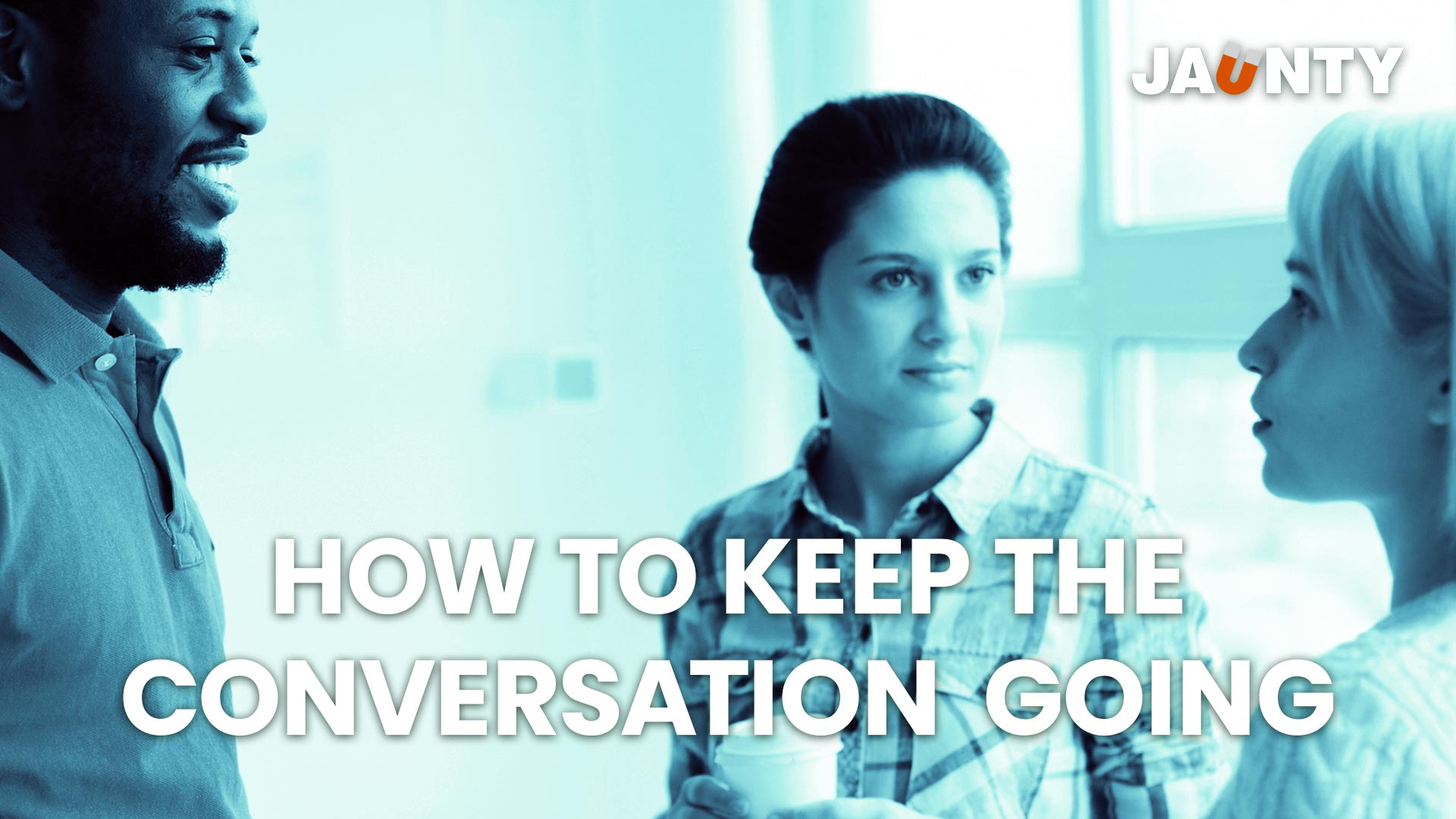A good conversation is all about rhythm, timing, and the exchange of ideas.
Whether you’re on a first date, catching up with friends, or networking with colleagues, the ability to keep a conversation going can turn a fleeting interaction into a lasting connection.
But if you’ve ever been unsure of how to break the ice or what to say next, let us assure you, you are not alone.
There is a reason one of the first things we’ve covered with thousands of students in our Social Skills Masterclass is how to have better conversations.
And we know that with the right guidance and a little practice anyone can increase their chances of having great conversations that leave everyone feeling positive and connected.
How To Keep A Conversation Going: Key Takeaways
- Listen actively
- Ask open-ended questions
- Share related stories
- Express genuine interest
- Use positive language
- Be observant
- Validate feelings
- Be yourself
- Practice empathy
- Know when to end a conversation
What Is A Good Conversation?
A good conversation is one that is engaging, informative, and enjoyable for all participants. It is a conversation that flows naturally, with both people feeling heard and understood.
Of course, not every interaction will be perfect. And it’s tough for many of us to strike the balance between talking, asking questions, and listening, while actively contributing and improving the conversation.
Here are some of the key characteristics of a good conversation
- Mutual respect: Both people feel respected and valued, and their opinions are considered.
- Active listening: Both people are paying attention to what the other person is saying, and they are responding thoughtfully.
- Shared interests: There is some common ground between the two people, which can help to keep the conversation going.
- Humor: A little bit of humor can help to lighten the mood and make the conversation more enjoyable.
- Open-mindedness: Both people are willing to consider different perspectives.
- Honesty: Both people are being honest with each other.
- Confidence: Both people feel confident in their ability to communicate effectively.
How To Keep A Conversation Going
1. Listen Actively
Active listening shows that you are genuinely interested in what the other person has to say, and it forms the foundation for a good conversation. This means fully focusing on the person you’re conversing with, paying attention to what they’re saying, and identifying the ‘threads’ or topics within their statements.
- Active listening involves maintaining eye contact, nodding, and responding appropriately to show engagement with the other person.
- Active listening makes it possible for you notes specific points of interest or topics that you can use to steer the conversation.
2. Identify Conversation Threads
Threads in a conversation can be anything from a place, a person, an event, or even a concept. For example, in the sentence, “I saw [mutual friend] at the mall last Saturday,” the threads could be ‘[mutual friend]’, ‘mall’, and ‘last Saturday’. Identifying these topics can provide the material for you to build upon and keep the conversation stimulating and engaging.
- Conversation threads are essentially topics or points of interest in a conversation.
- They provide leads that you can follow to steer the conversation.
3. Pick Interesting Topics
Once you’ve identified the threads in a conversation, the next step is to pick one that interests you or you think could lead to a more engaging conversation. You can then use this thread to ask a question, share a related experience, or express an opinion. This helps to keep the conversation flowing and engaging.
- Picking a thread involves choosing a point of interest from the conversation and building upon it.
- This could be through asking a question, sharing a related experience, or expressing an opinion.
4. Ask Open-Ended Questions
Open-ended questions require more than a simple ‘yes’ or ‘no’ answers and can lead to more detailed responses, providing more threads for you to pick up on.
- Open-ended questions may encourage the other person to share more.
- Good open-ended questions will make conversations more engaging, memorable, and meaningful.
5. Relate And Respond
Relate to your conversation partner and respond appropriately. This could entail anything from sharing a similar experience, expressing an opinion, or asking a follow-up question.
- Relating and responding appropriately to what they are saying keeps the conversation flowing and engaging.
- Genuinely connecting with those you frequently converse with can build and strengthen relationships.
6. Share Related Experiences or Thoughts
Sharing your own experiences or thoughts that are related to the thread can make the conversation more dynamic and personal.
- Sharing related experiences or thoughts makes the conversation more dynamic and personal.
- It shows empathy and can help build a deeper connection with the other person.
7. Avoid Monopolizing the Conversation
While conversation threading is about keeping the conversation going, it’s important to ensure that it’s balanced. Avoid talking too much about yourself, and give the other person plenty of opportunities to speak.
- A good conversation is a two-way street. It’s not just about expressing your thoughts and ideas, but also about listening to and understanding the other person’s perspective.
- Give the other person plenty of opportunities to speak and express their thoughts and ideas.
8. Use Non-Verbal Cues
Non-verbal communication plays a crucial role in conversations. Social cues and physical cues like smiling, nodding, and using hand gestures can make the conversation more lively and engaging. It also helps to show that you are actively listening and interested in what the other person is saying.
- Non-verbal cues like smiling and nodding can help show that you are actively listening and interested in the conversation.
- They can make the conversation more lively and engaging.
9. Follow Up on Previous Topics
If there’s a lull in the conversation, you can revisit something the person mentioned earlier. This shows that you were paying attention and are interested in what they have to say. It also provides an opportunity to delve deeper into a topic and explore it further.
- Following up on previous topics can help keep the conversation going and show that you are genuinely interested in what the other person has to say.
- It provides an opportunity to delve deeper into a topic and explore it further.
10. Adjust the Topic as Needed
If you sense that the other person is not interested in a topic, it’s okay to switch to something else. Pay attention to their non-verbal cues for guidance. Being flexible and adaptable in a conversation can make it more enjoyable and engaging for both parties, but also know how to be more assertive when needed.
- Being flexible and adaptable in a conversation can make it more enjoyable and engaging.
- If the other person seems uninterested in a topic, switch to something else.
11. Express Genuine Interest and Curiosity
People enjoy talking about their interests and passions. Encourage them to talk more about what they love, and show genuine curiosity. This not only keeps the conversation going, but also makes the other person feel valued and appreciated.
- Expressing genuine interest and curiosity can make the other person feel valued and appreciated.
- It encourages them to share more about their interests and passions, making the conversation more engaging and meaningful.
12. Avoid Controversial or Negative Topics
Unless you know the person well, it’s usually best to steer clear of topics that could lead to arguments or negative feelings. Keeping the conversation light and positive can make it more enjoyable and less stressful for both parties.
- Avoiding controversial or negative topics can make the conversation more enjoyable and less stressful.
- Keeping the conversation light and positive can foster a more relaxed and friendly atmosphere.
13. Use Humor Wisely
A little humor can lighten the conversation and make it more enjoyable. However, be cautious with jokes and sarcasm unless you’re sure how the other person will take it. Being funny in conversation can be a great tool for building rapport, but it should be used wisely and appropriately.
- Humor can lighten the conversation and make it more enjoyable.
- However, it should be used wisely and appropriately to avoid misunderstandings or offense.
14. Empathize and Validate
Show understanding and empathy towards the other person’s feelings and experiences. Validation can be as simple as saying, “That sounds challenging,” or “I can see why you’d feel that way.” This not only shows that you are listening and understanding, but also that you value their feelings and experiences.
- Empathy and validation show that you are listening and understanding, and that you value the other person’s feelings and experiences.
- They can help build a deeper connection and make the conversation more meaningful.
15. Explore Their Interests
People often enjoy talking about their hobbies, jobs, or interests. Asking questions about these topics can make the conversation more engaging for them. It also provides an opportunity to learn more about the other person and find common ground.
- Exploring the other person’s interests can make the conversation more engaging and provide an opportunity to learn more about them.
- It can also help find common ground, which is a key element in building rapport and connection.
16. Be Observant
Use your surroundings or current events as conversation starters or topics. This can be especially useful when meeting new people, where the environment can offer several cues. Being observant not only provides material for the conversation, but also shows that you are present and engaged.
- Being observant can provide material for the conversation and show that you are present and engaged.
- It can be especially useful in face-to-face meetings where the environment can offer several cues.
17. Mind the Pace
Be aware of the conversation’s pace. Don’t rush it, but also be mindful not to let it drag. A natural pace makes the conversation more comfortable for everyone. It also allows for pauses, which can give both parties a chance to think and respond more thoughtfully.
- Minding the pace of the conversation can make it more comfortable for everyone.
- It allows for pauses, which can give both parties a chance to think and respond more thoughtfully.
18. Use Positive Language
Keeping the conversation positive and uplifting can leave a good impression. People are generally drawn to positivity and are more likely to remember the conversation fondly. Positive language can also help foster a more friendly and relaxed atmosphere.
- Using positive language can leave a good impression and foster a more friendly and relaxed atmosphere.
- People are generally drawn to positivity and are more likely to remember the conversation fondly.
19. Be Yourself
Authenticity is key in any conversation. Being genuine in your responses and interests makes for a more meaningful and comfortable conversation. It also helps build trust and rapport, as people are more likely to open up to someone who is authentic and sincere.
- Being genuine in your responses and interests makes for a more meaningful and comfortable conversation.
- Authenticity helps build trust and rapport, as people are more likely to open up to someone who is authentic and sincere.
20. Know When to End the Conversation
Recognizing when a conversation has reached its natural conclusion is important. Dragging it on can make it less enjoyable. It’s okay to politely end a conversation when it seems to have run its course.
- Recognizing when to end the conversation can make it more enjoyable and leave room for future conversations.
- It’s okay to politely end a conversation when it seems to have run its course. This ends the current one on a positive note.
21. Practice
Like any other skill, conversation threading requires practice. The more you use it, the more natural it will become, and the better you’ll get at keeping conversations going. Attend a variety of events and social activities to find people to converse with.
- Conversation threading requires practice. The more you use it, the more natural it will become.
- The goal is not just to keep the conversation going, but also to make it more engaging and meaningful.
How Can I Keep a Conversation Going Without Awkward Silences?
To avoid awkward silences, engage in active listening and show interest in the conversation. This involves paying attention to what the other person is saying and looking for ‘threads’—topics or points of interest you can ask questions about or share related experiences.
Additionally, asking open-ended questions that require more than a yes or no answer can encourage the other person to elaborate and provide more content for the conversation.
What Are Some Effective Strategies to Revive a Conversation?
When a conversation starts to fizzle out, you can revive it by bringing up new topics, asking follow-up questions, or revisiting something the person mentioned earlier. Sharing an anecdote or a piece of interesting information can also inject new life into the discussion.
Another strategy is to shift the focus to the other person’s interests or experiences, which can reignite their enthusiasm and, in turn, the conversation. Being observant of your surroundings can also provide fresh topics to discuss.
How Do I Ensure I’m Not Dominating the Conversation?
To ensure a balanced conversation, practice active listening and give the other person ample opportunity to speak. Pay attention to their verbal and non-verbal cues to gauge if they are engaged or if they want to say something. It’s also important to be mindful of the amount of time you spend talking.
If you find yourself speaking at length, pause and invite the other person to share their thoughts or experiences related to the topic. If you find yourself constantly interrupting people or engaging in other “conversation killers,” no matter how hard you try not to, it might be a good time to consider working with a social skills coach who can help you achieve your goals.



